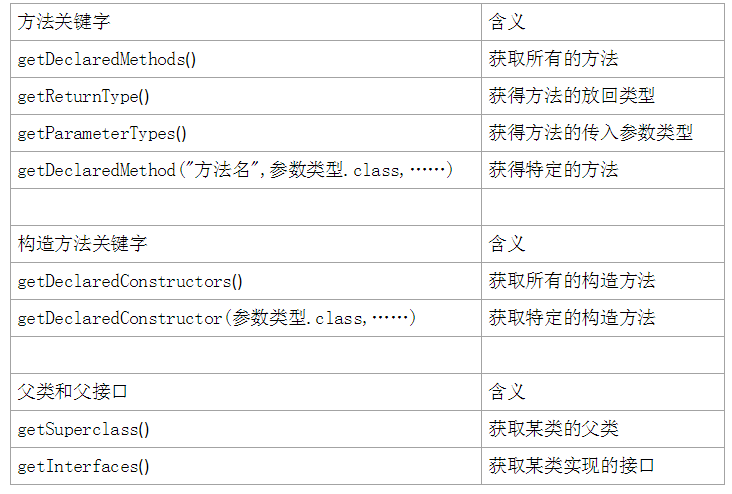Home >Java >javaTutorial >Reflection mechanism in JAVA
Reflection mechanism in JAVA
- 高洛峰Original
- 2016-12-12 11:40:471338browse
常 Reflex, I often listened to them at the time that I have seen some information, and may have been used in the design mode, but I feel that I do n’t have a deeper understanding of it. This time I re -learned it. It feels okay!
Third, let’s take a look at the classes that sun provides us with in the reflection mechanism:
We can query many methods, attributes and other operations in reflection from these four classes. Or should we learn to constantly query the API, that is our best teacher.
‐ invited - requested,” in, to use.
//第一种方式:
Classc1 = Class.forName("Employee");
//第二种方式:
//java中每个类型都有class 属性.
Classc2 = Employee.class;
//第三种方式:
//java语言中任何一个java对象都有getClass 方法
Employeee = new Employee();
Classc3 = e.getClass(); //c3是运行时类 (e的运行时类是Employee)3. Obtain attributes: divided into all attributes and specified attributes:
a. Let’s first look at how to get all attributes:
[java] view plain copy
print?
Class c =Class.forName("Employee");
//创建此Class 对象所表示的类的一个新实例
Objecto = c.newInstance(); //调用了Employee的无参数构造方法.b. Get specific attributes and learn by comparing with traditional methods:
//获取整个类
Class c = Class.forName("java.lang.Integer");
//获取所有的属性?
Field[] fs = c.getDeclaredFields();
//定义可变长的字符串,用来存储属性
StringBuffer sb = new StringBuffer();
//通过追加的方法,将每个属性拼接到此字符串中
//最外边的public定义
sb.append(Modifier.toString(c.getModifiers()) + " class " + c.getSimpleName() +"{\n");
//里边的每一个属性
for(Field field:fs){
sb.append("\t");//空格
sb.append(Modifier.toString(field.getModifiers())+" ");//获得属性的修饰符,例如public,static等等
sb.append(field.getType().getSimpleName() + " ");//属性的类型的名字
sb.append(field.getName()+";\n");//属性的名字+回车
}
sb.append("}");
System.out.println(sb); 4. The acquisition method and construction method will not be described in detail. Just look at the keywords:
In this way, we can obtain various contents of the class and decompile them. For a language like JAVA that compiles first and then runs, the reflection mechanism can make the code more flexible and easier to implement object-oriented.加 射 射 射 射, reflects and configuration files, make our program more flexible: In the design mode learning, we use reflection when learning abstract factories to read the database link string, etc. I didn’t quite understand it, so I just copied it. Take a look at the use of reflection+configuration files in .NET: The configuration file used at the time was the app.config file, the content was xml format, and the content of the link database was filled in. The advantage is that it is very easy for us to change the database. For example, if we upgrade the system database from SQL Server to Oracle, then we write two D layers, change the content of the configuration file, or add conditions to select it, and it will bring A great convenience. J Of course, the same is true in Java, but the configuration file here is. PROPERTIES, called attribute files. Read the content inside through reflection. In this way, the code is fixed, but we can change the content of the configuration file, which makes our code much more flexible!
In summary, relearning JAVA reflection and using it flexibly can make our code more flexible, but it also has its shortcomings, that is, using it will reduce the performance and increase the complexity of our software, so we need to We use it carefully.
Related articles
See more- How to Pass a Serializable List of Objects via Intent in Android?
- Why Can't I Use Generic Type Parameters in a Java Static Method?
- How to Continuously Update a JLabel Using Swing Timer and SwingWorker?
- Where Should You Place Your JFrames?
- Why Does My Classpath Resource Cause a FileNotFoundException When Running My JAR?

